
Concept explainers
In Example 2.6, we considered a simple model for a rocket launched from the surface of the Earth. A better expression for the rocket’s position measured from the center of the Earth is given by
where
a. Derive expressions for
b. Plot y(t), vy(t), and ay(t). (A spreadsheet program would be helpful.)
c. When will the rocket be at
d. What are
(a)
The expressions for
Answer to Problem 46PQ
The expression for
Explanation of Solution
Write the given expression for the position vector.
Here,
Velocity is the time derivative of position vector. Write the equation for velocity.
Here,
Acceleration is the time derivative of velocity. Write the expression for acceleration.
Here,
Conclusion:
Put equation (I) in equation (II).
Put equation (IV) in equation (III).
Therefore, the expression for
(b)
Plots of
Answer to Problem 46PQ
The plot of
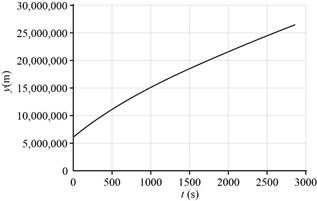
The plot of
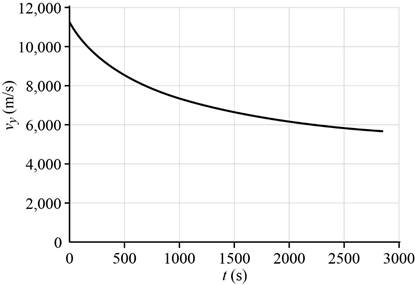
And the plot of
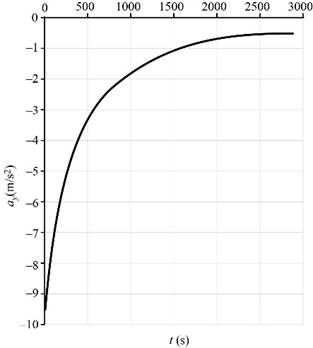
Explanation of Solution
The graph of position versus time of an object gives the position of the object at different instant of time. The slope of the position versus time graph gives the magnitude of the velocity of the object. In velocity versus time graph of an object, its velocity at different instants of time is plotted. The slope of this graph gives the magnitude of acceleration of the object. In acceleration versus time graph, acceleration is plotted as a function of time.
The plot of
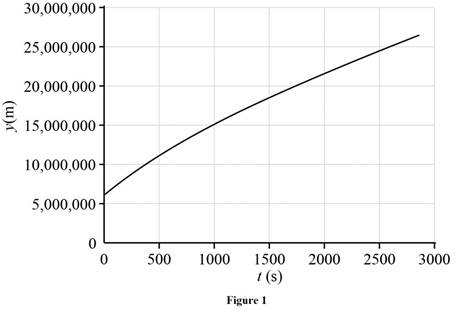
The plot of
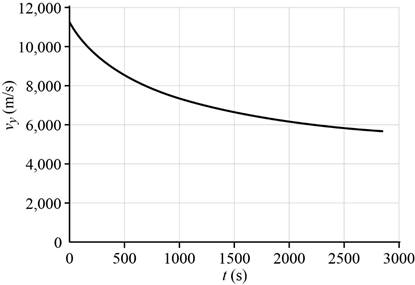
From the figure it is clear that the rocket has maximum velocity when it starts its motion and the velocity decreases with time. The graph has negative slope implying the acceleration is negative.
The plot of
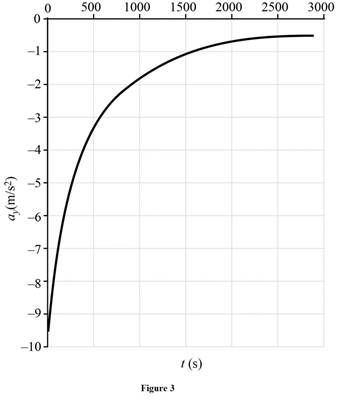
From the figure, it is clear that the rocket has negative acceleration.
(c)
The time at which the rocket will be at
Answer to Problem 46PQ
The time at which the rocket will be at
Explanation of Solution
Equation (I) can be used to determine the time at which the rocket will be at
Substitute
Take the power
Conclusion:
Given that the radius of the Earth is
Substitute
Therefore, the time at which the rocket will be at
(d)
The value of
Answer to Problem 46PQ
The value of
Explanation of Solution
Equation (IV) can be used to determine the value of
Conclusion:
Substitute
Substitute
Therefore, the value of
Want to see more full solutions like this?
Chapter 2 Solutions
EBK WEBASSIGN FOR KATZ'S PHYSICS FOR SC
- RT = 4.7E-30 18V IT = 2.3E-3A+ 12 38Ω ли 56Ω ли r5 27Ω ли r3 28Ω r4 > 75Ω r6 600 0.343V 75.8A Now figure out how much current in going through the r4 resistor. |4 = unit And then use that current to find the voltage drop across the r resistor. V4 = unitarrow_forward7 Find the volume inside the cone z² = x²+y², above the (x, y) plane, and between the spheres x²+y²+z² = 1 and x² + y²+z² = 4. Hint: use spherical polar coordinates.arrow_forwardганм Two long, straight wires are oriented perpendicular to the page, as shown in the figure(Figure 1). The current in one wire is I₁ = 3.0 A, pointing into the page, and the current in the other wire is 12 4.0 A, pointing out of the page. = Find the magnitude and direction of the net magnetic field at point P. Express your answer using two significant figures. VO ΜΕ ΑΣΦ ? Figure P 5.0 cm 5.0 cm ₁ = 3.0 A 12 = 4.0 A B: μΤ You have already submitted this answer. Enter a new answer. No credit lost. Try again. Submit Previous Answers Request Answer 1 of 1 Part B X Express your answer using two significant figures. ΜΕ ΑΣΦ 0 = 0 ? below the dashed line to the right P You have already submitted this answer. Enter a new answer. No credit lost. Try again.arrow_forward
 Principles of Physics: A Calculus-Based TextPhysicsISBN:9781133104261Author:Raymond A. Serway, John W. JewettPublisher:Cengage Learning
Principles of Physics: A Calculus-Based TextPhysicsISBN:9781133104261Author:Raymond A. Serway, John W. JewettPublisher:Cengage Learning College PhysicsPhysicsISBN:9781285737027Author:Raymond A. Serway, Chris VuillePublisher:Cengage Learning
College PhysicsPhysicsISBN:9781285737027Author:Raymond A. Serway, Chris VuillePublisher:Cengage Learning Physics for Scientists and Engineers, Technology ...PhysicsISBN:9781305116399Author:Raymond A. Serway, John W. JewettPublisher:Cengage Learning
Physics for Scientists and Engineers, Technology ...PhysicsISBN:9781305116399Author:Raymond A. Serway, John W. JewettPublisher:Cengage Learning Physics for Scientists and EngineersPhysicsISBN:9781337553278Author:Raymond A. Serway, John W. JewettPublisher:Cengage Learning
Physics for Scientists and EngineersPhysicsISBN:9781337553278Author:Raymond A. Serway, John W. JewettPublisher:Cengage Learning Physics for Scientists and Engineers with Modern ...PhysicsISBN:9781337553292Author:Raymond A. Serway, John W. JewettPublisher:Cengage Learning
Physics for Scientists and Engineers with Modern ...PhysicsISBN:9781337553292Author:Raymond A. Serway, John W. JewettPublisher:Cengage Learning University Physics Volume 1PhysicsISBN:9781938168277Author:William Moebs, Samuel J. Ling, Jeff SannyPublisher:OpenStax - Rice University
University Physics Volume 1PhysicsISBN:9781938168277Author:William Moebs, Samuel J. Ling, Jeff SannyPublisher:OpenStax - Rice University





